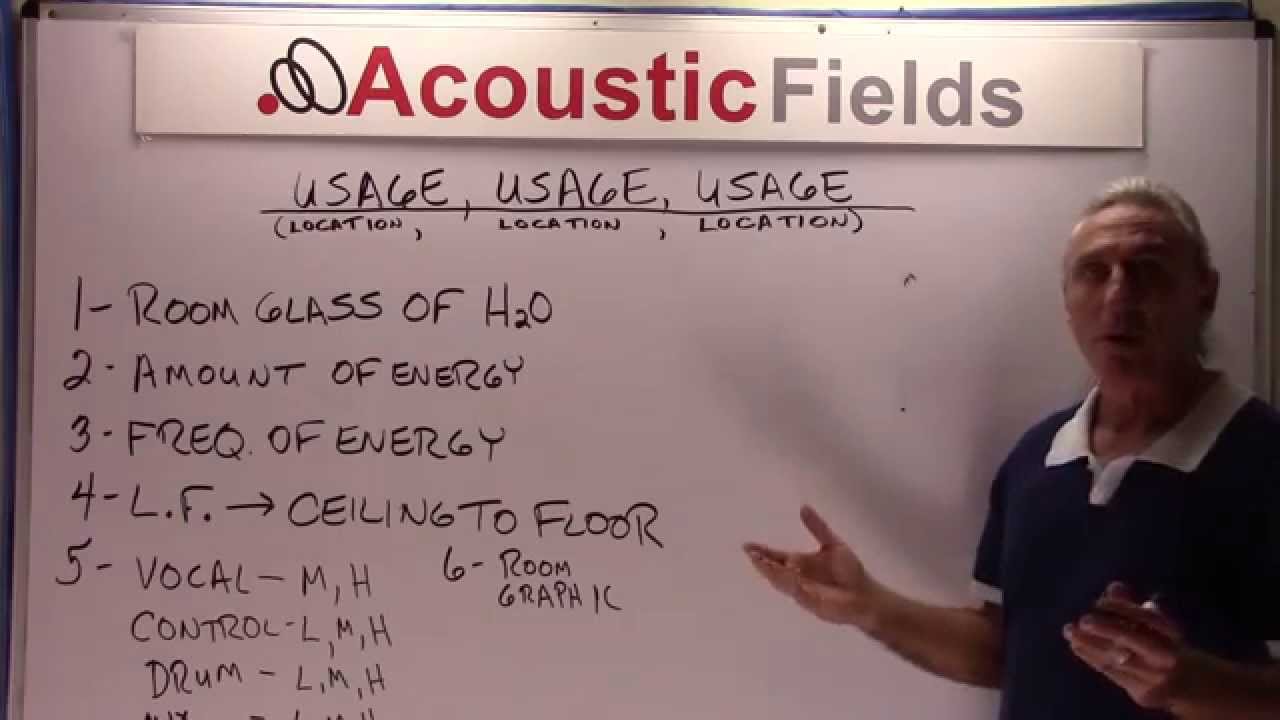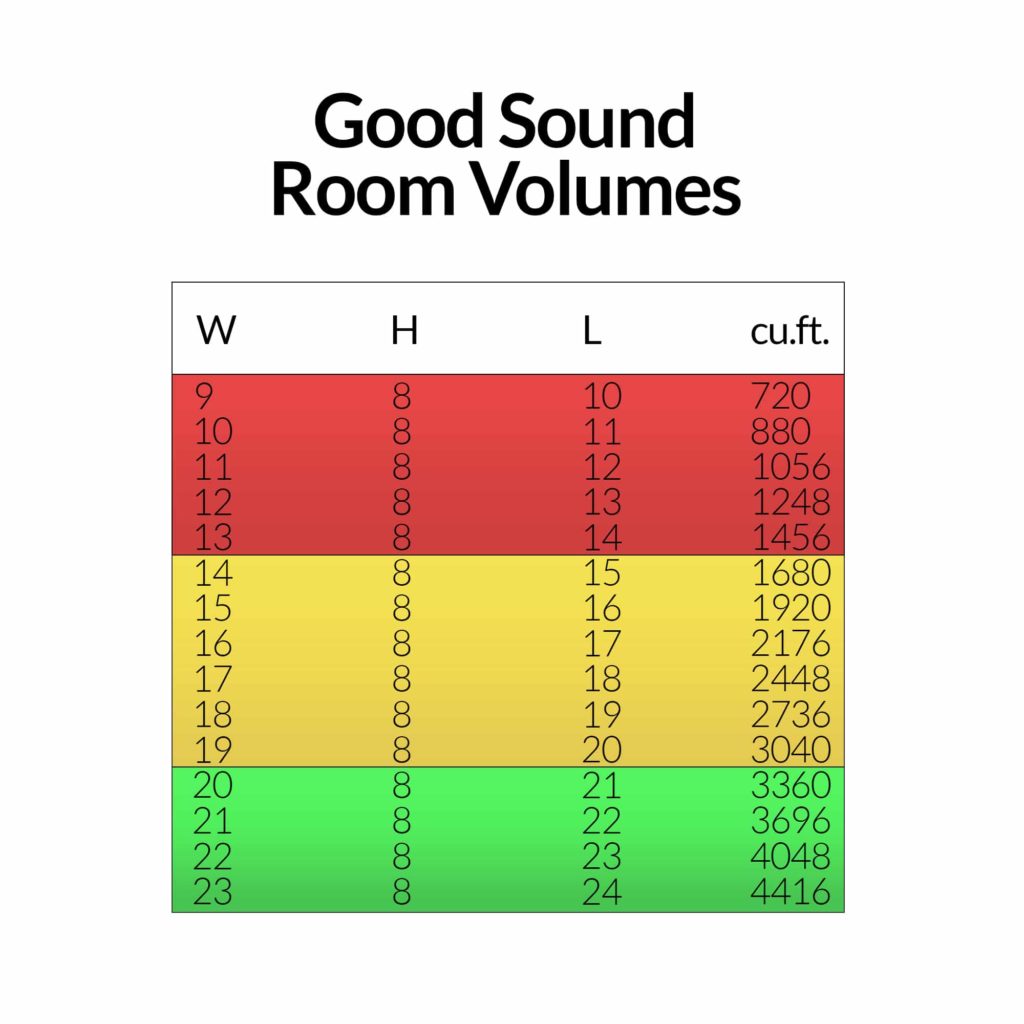Today we are going to talk about room usage.
Do you remember that old adage in real estate, location, location, location, is the most important part? Well, in room acoustics it’s really usage, usage, usage, because what you’re doing in the room, tells you about the size that you need, the volume that you need, what kind of treatments you need, noise levels, all kinds of issues. So usage of the room is really critical. To understand a little bit of this, let’s think about room as a glass of water. We have all this energy in the room. We have low frequency, middle and high frequency energy. So all this energy raises the water level in our room, or glass. Above our head we can’t hear. So it’s a way of looking at energy in the room and creating noise if you will so that you can’t hear certain things, and then we get in to all kinds of issues with the amount of energy, and the frequency of the energy. Especially with low frequency energy we have long waves of energy that simply won’t fit in the room. So they create all kinds of residences, and all kinds of issues that we have to deal with at different locations in the room. One of the locations in the room, especially with low frequency energy, is floor to ceiling.
That’s an area that’s often overlooked, but if you think about it, especially in North America, I think in most areas of the world, that is our shortest distance. So the shortest distance when it becomes problematic with lower frequencies that are longer and won’t fit. So that’s an area you have to be really careful of. If we look at usage, we look at the frequency and we look at the amount of energy in the room, we know that in a vocals room we have mids and highs we have to worry about, nothing really below a hundred cycles. But control, drum, mix, in almost every other room we have full range requirements, so we need to be able to manage and handle all that energy. That’s a good way to look at the differences between requirements. A vocal room would not even be close in size requirements, to a control, drum or mixing room. So these three here have way different requirements than a vocal room. We have to look at usage, because the usage determines what we’re doing. If it’s two channel listing, if it’s home theater, if it’s a drum room. Just comparing contrast based on your experience the difference in energy requirements between a drum room and a vocal room. You can see that usage is really critical here.
So in this graphic I’ve taken room vibes and I’ve divided it up in three parts. One part is under 1500 cu.ft. The next part is under 3000 cu.ft, and the third part is under 4500 cu.ft. That’s based on our database and what we’ve seen is that issues in those room volumes or anything below those numbers you can see in the red area, it’s almost a no go acoustically, because the amount of treatments that you have to put in, makes the room so small. Below 3000 is problematic, you can have certain sizes that you can see in the graph that will work with treatment. And of course 4500 is a magical number, we see very few issues that are easily managed, at those volume levels. So usage usage usage, remember that when you’re talking about room, and one size acoustically does not fit all.
—
This is an unedited transcript from our video series from Acoustic Fields. There will be some errors in grammar and sentence structure that occur during this translation process.
For complete understanding and comprehension, please view the video which is included in this text. For any additional information regarding this topic or others relating to room acoustics, please contact us directly at:
P: 520 – 392 – 9486









Hi Dennis. Thanks for putting together all of this learning material.
I have a question regarding your video titled “usage, usage, usage”. You say that a room might have low frequency, middle frequency and high frequency components. You then go on to talk about the different energies in the room. Am I right in thinking energy in this instance is proportional to amplitude, and not frequency? Your video made me question that.
Also, you say that you get into trouble when the dimensions of a room don’t accommodate a wavelength of a low frequency sound. I thought if a particular wavelength is below the cut-off frequency then it isn’t supported – no problem. Or are you saying that there would be a “dead spot” in the frequency content below the cut-off frequency, and that is the problem?
Thanks,
Alex
Hi Alex,
There are waves and rays of energy in your room. Waves are low frequency energy below 100 Hz. Rays are energy above 100 Hz. Waves are long energy forms with 30, 40, 50′ lengths. Rays are 11′ and shorter. The goal is to get all the waves and rays to fit together within the room. If they fit into the room well and well includes many variables, then you have a equal representation of all frequencies. An equal representation of waves and rays means that you at least have a chance to hear everything in the recorded source. Waves or low frequency energy that does not fit into the room will exaggerate and conceal other energy of less strength or amplitude. Think of your room as a glass of water. If you have too much lower frequency energy, your glass is overflowing with water and neither waves or rays can be heard. The solution is to drop sponges or lower frequency absorption technology into your glass to reduce or lower the water level.
Hi Dennis. Thank you for your quick reply. I’ve been working in environmental acoustics for a while but have no experience in room acoustics. It takes me by surprise that low frequency content is exaggerated if it cannot fit into a room. I expected that if the room dimensions don’t support it, then it won’t exist?
I would expect a particular frequency component to become exaggerated only when the room dimension is exactly some multiple of the corresponding wavelength, creating a standing wave.
Is this right/wrong?